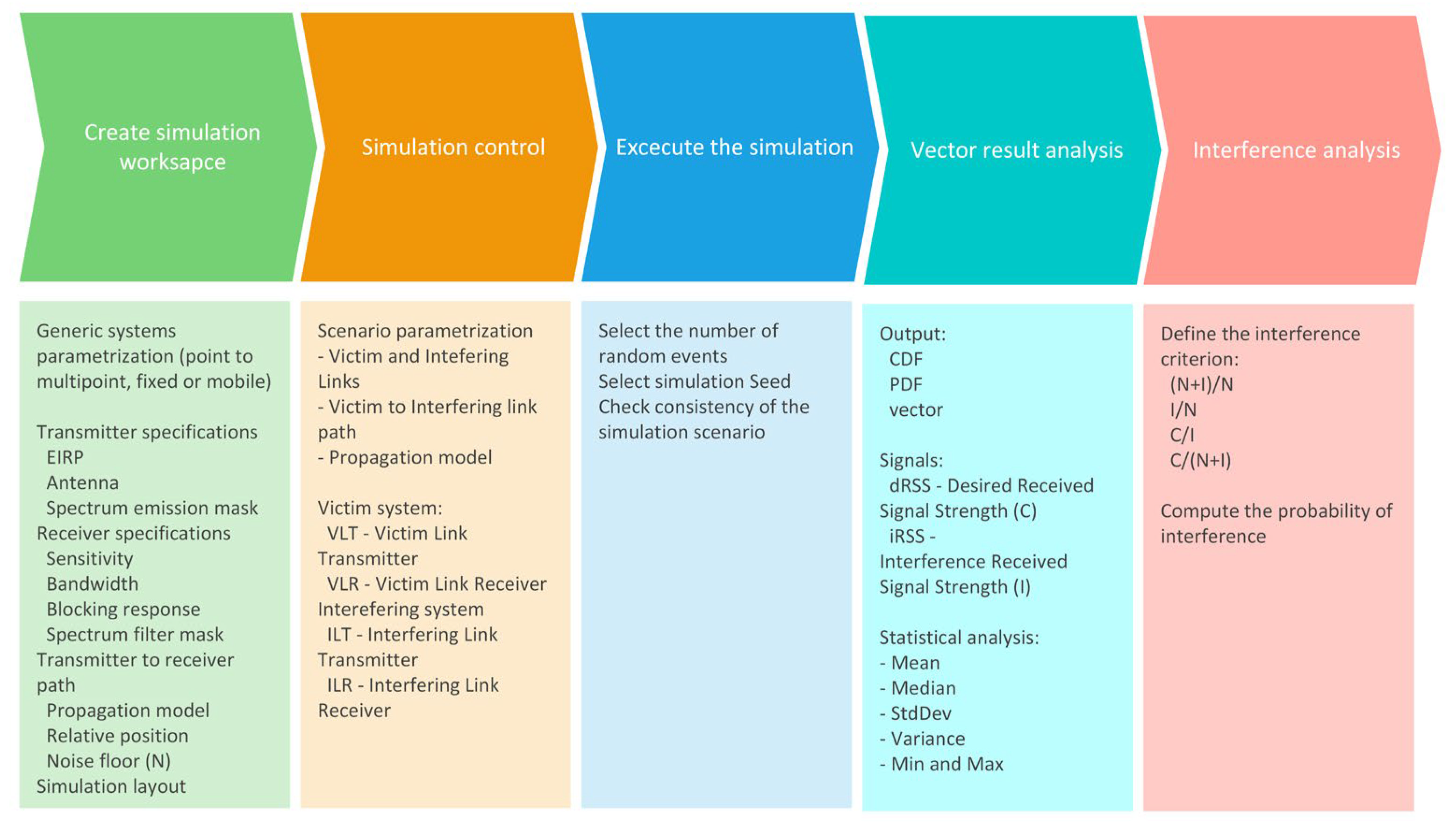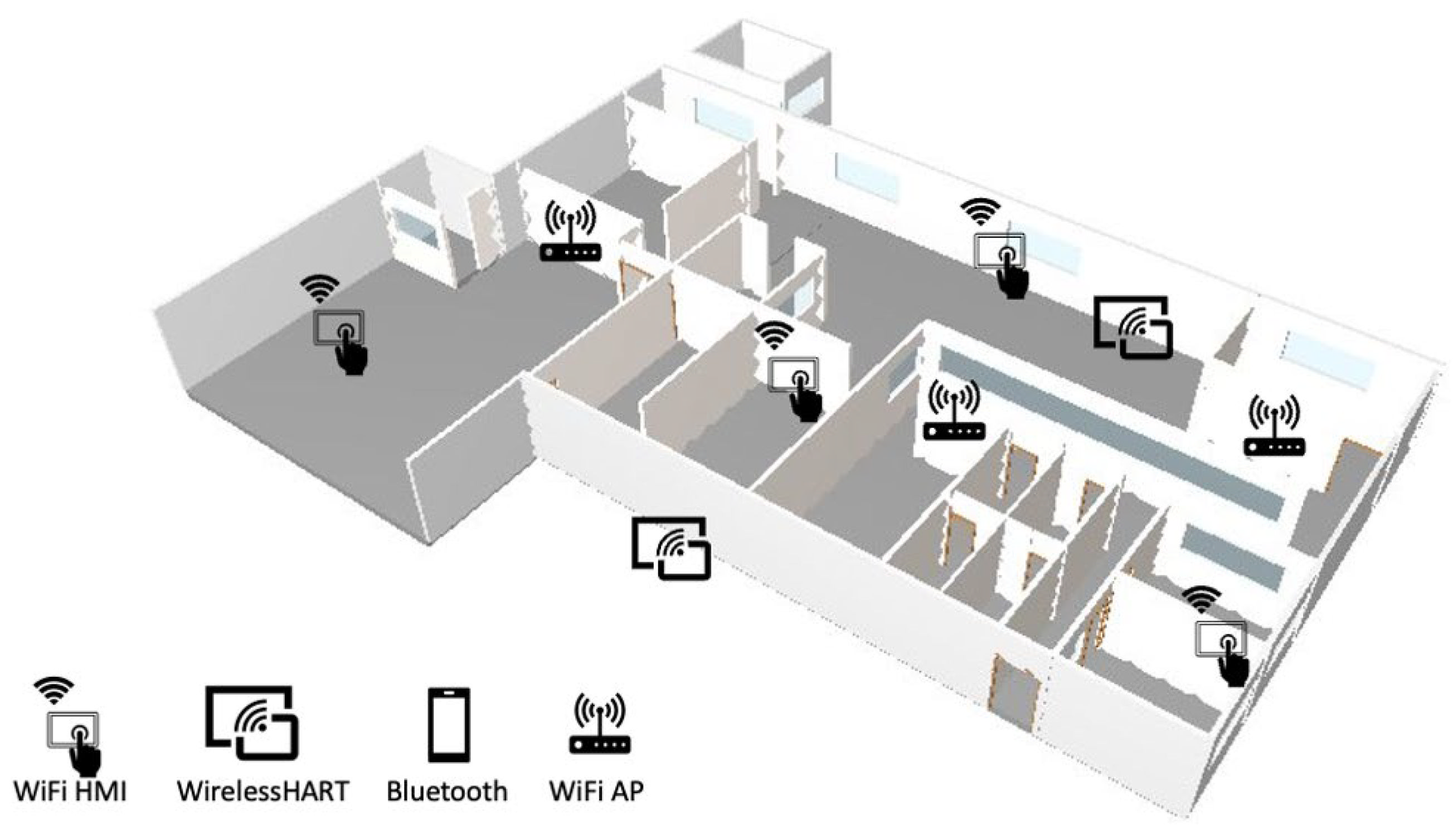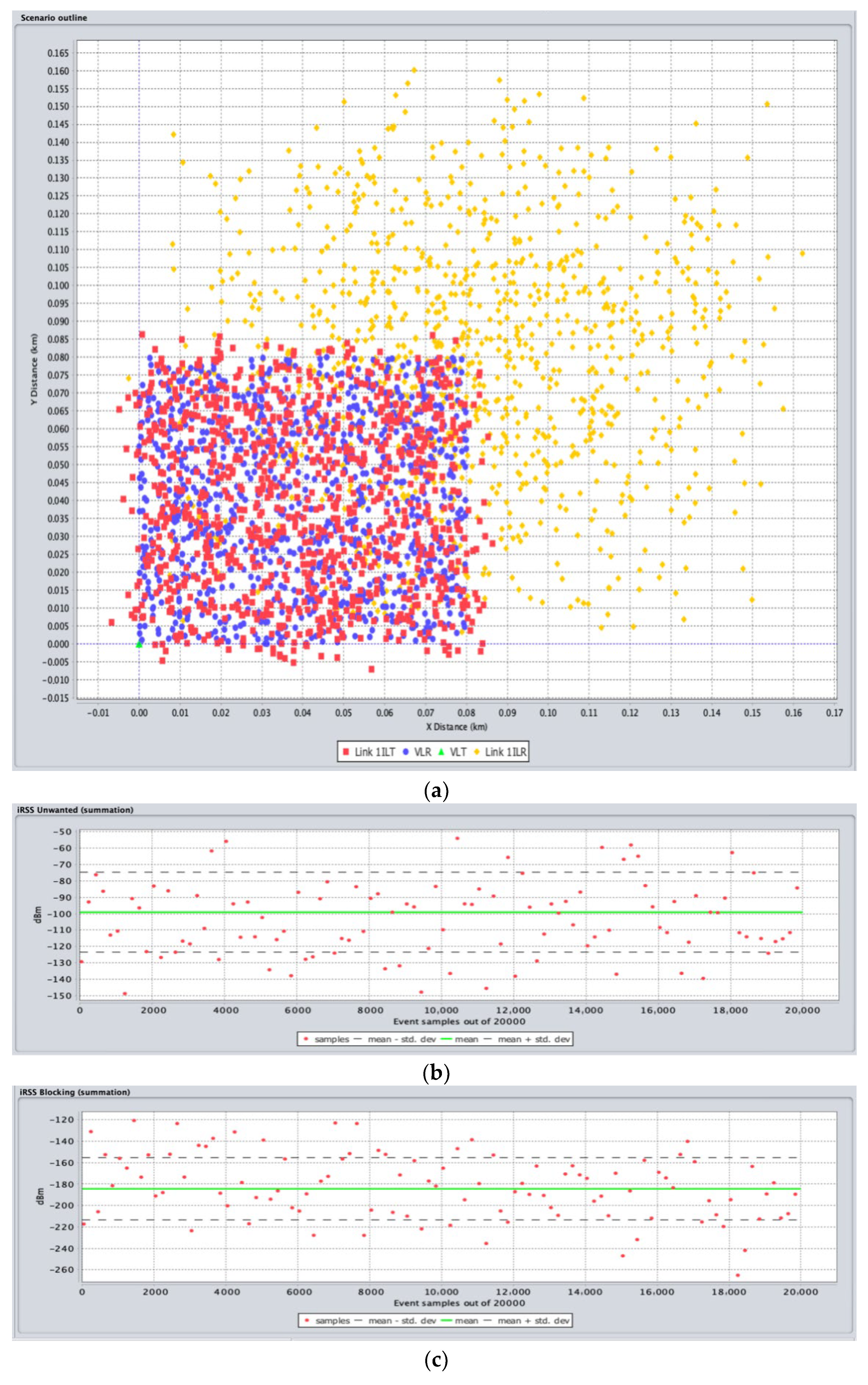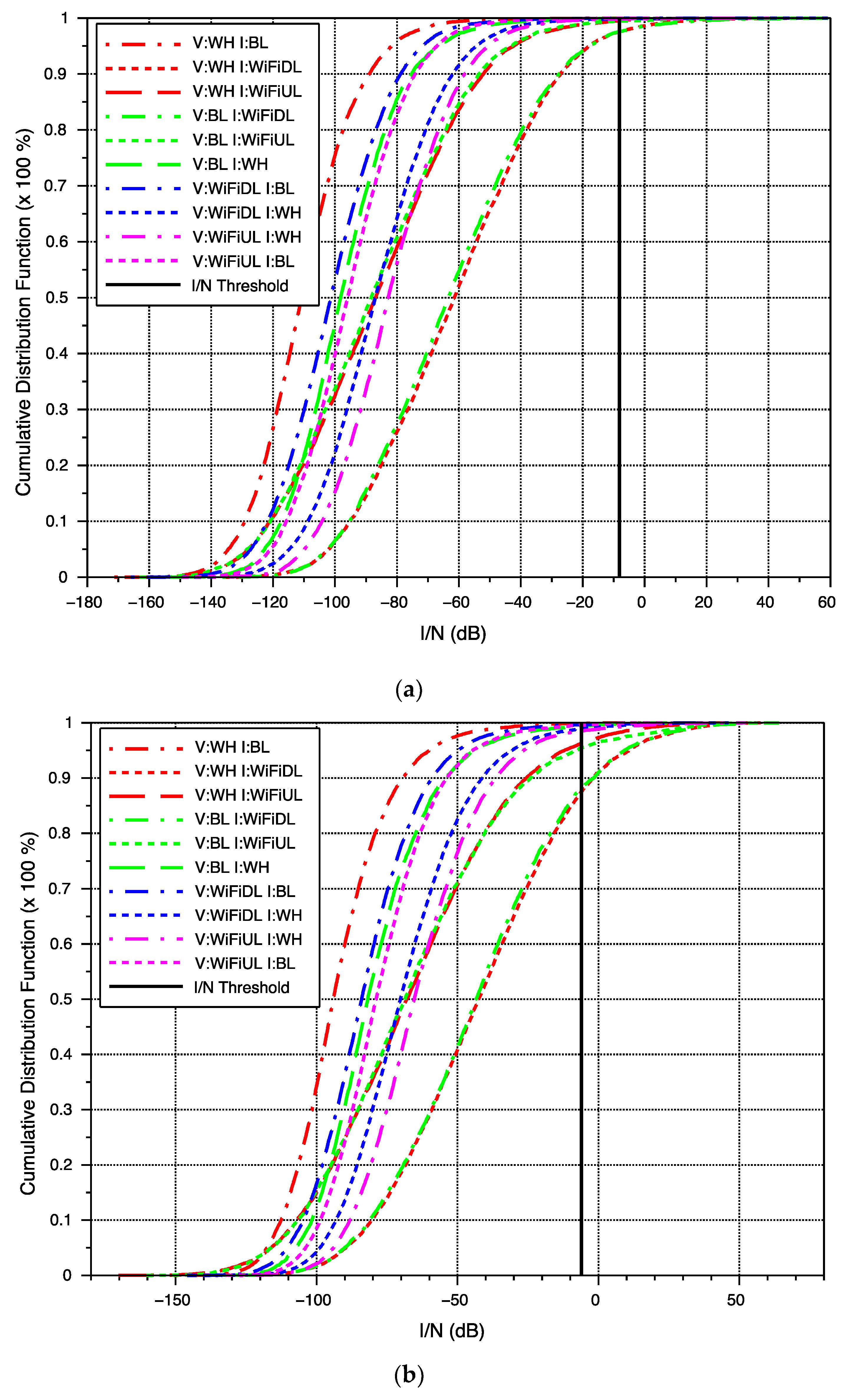Radio Interference of Wireless Networks and the Impact of AR/VR Applications in Industrial Environments
Abstract
:1. Introduction
1.1. Contributions of the Study
- First, to investigate how the density of wireless devices, which can be deployed in a confined industrial environment, can interfere with the interaction experience of users in mobile applications, particularly those with computational and memory-intensive requirements which are more demanding in terms of bandwidth and latency.
- Second, to discuss how the growing number of mobile AR/VR applications may affect the radio interference of different types of wireless networks that coexist in the same industrial environment.
1.2. Paper Structure
2. Challenges and Related Work
2.1. Challenges
- Computing efficiency—Mobile AR/VR applications are computation and data-intensive applications. Thus, the computational and rendering abilities of mobile devices play an important role in the improvement of the performance of mobile AR applications. However, current mobile devices present an inefficient runtime environment because of their limited computational and storage abilities, and this may lead to very low frames per second (FPS) [14,15,16].
- Network communication efficiency. Because of the limited computing efficiency and limited battery capacity of mobile devices, offloading the tasks to a remote server is a common practice. This requires sufficient bandwidth and incurs additional delays during the interactions and may influence the user experience, as the latency caused by the communication with the remote servers must have very low values to be imperceptible to the user [14,15,16,17]. In addition, sending more data on the uplink (from the mobile device to a remote server) than receiving it on the downlink may cause some performance issues for other connections sharing the same asymmetric bottleneck [18].
- Compatibility and standardization—It is important to build technology-independent mobile AR/VR services (hardware-independent, browser-independent, producer-independent) using standardized technologies [14,15]. However, achieving this poses several challenges [15]: mobile hardware has different levels of support for AR; there is no standardization of techniques to define the common protocols and application programming interfaces (APIs) to simplify the deployment; and modern web browsers and built-in browsers have very different capabilities to support AR applications and lack a standard for web 3D objects.
- Privacy and Security—AR/VR mobile applications may collect more personal information (such as personal identification or location information) than traditional systems, and this can impact user privacy. Therefore, mechanisms for data generation and mechanisms of data access, as well as a secure network environment for data transmission, are required [14]. However, a trade-off needs to be found between the user’s privacy and the amount of personal data required for the appropriate behavior of the application [18].
- Application Deployment—The demand for mobile AR/VR applications is high, but there are still many limitations. As more open-source software and more development platforms and educational programs for AR are made publicly available, more AR applications will emerge [14].
2.2. Related Work
- Research that analyzes the influence of wireless network efficiency on mobile AR applications and possible solutions to face the challenges encountered;
- Research on radio interference analysis of wireless networks in industrial environments.
3. Methodology
4. Radio System Specifications
5. Simulation Planning
- Victim: WirelessHART–interferer: Bluetooth;
- Victim: WirelessHART–interferer: Wi-Fi DL;
- Victim: WirelessHART–interferer: Wi-Fi UL;
- Victim: Bluetooth–interferer: Wi-Fi DL;
- Victim: Bluetooth–interferer: Wi-Fi UL;
- Victim: Bluetooth–interferer: WirelessHART;
- Victim: Wi-Fi DL–interferer: Bluetooth;
- Victim: Wi-Fi DL– interferer: WirelessHART;
- Victim: Wi-Fi UL– interferer: WirelessHART;
- Victim: Wi-Fi UL–interferer: Bluetooth.
6. Simulation Results and Discussion
7. Conclusions
Author Contributions
Funding
Data Availability Statement
Conflicts of Interest
References
- Poor, R.; Hodges, B. Reliable Wireless Networks for Industrial Systems; Ember Corporation: Boston, MA, USA, 2002. [Google Scholar]
- Breitkreuz, D.; Müller, M.; Stegelmeyer, D.; Mishra, R. Augmented Reality Remote Maintenance in Industry: A Systematic Literature Review. Lect. Notes Comput. Sci. 2022, 13446, 287–305. [Google Scholar] [CrossRef]
- Mourtzis, D.; Siatras, V.; Angelopoulos, J. Real-time remote maintenance support based on augmented reality (AR). Appl. Sci. 2020, 10, 1855. [Google Scholar] [CrossRef] [Green Version]
- Venerella, J.; Franklin, T.; Sherpa, L.; Tang, H.; Zhu, Z. Integrating ar and vr for mobile remote collaboration. In Proceedings of the 2019 IEEE International Symposium on Mixed and Augmented Reality, ISMAR-Adjunct 2019, Beijing, China, 10–18 October 2019; pp. 104–108. [Google Scholar] [CrossRef]
- Piumsomboon, T.; Lee, Y.; Lee, G.; Billinghurst, M. CoVAR: A collaborative virtual and augmented reality system for remote collaboration. In Proceedings of the SIGGRAPH Asia 2017 Emerging Technologies, Bangkok, Thailand, 27–30 November 2017. [Google Scholar] [CrossRef]
- Chang, Y.-L.; Tien, C.-L. Development of mobile augmented-reality and virtual-reality simulated training systems for marine ecology education. In Proceedings of the Proceedings-Web3D 2019: 24th International ACM Conference on 3D Web Technology (2019), Los Angeles, CA USA, 26–28 July 2019. [Google Scholar] [CrossRef]
- Bacca, J.; Baldiris, S.; Fabregat, R.; Kinshuk Graf, S. Mobile Augmented Reality in Vocational Education and Training. Procedia Comput. Sci. 2015, 75, 49–58. [Google Scholar] [CrossRef] [Green Version]
- HMS Networks: 5G: Is the industry ready? Available online: https://www.hms-networks.com/technologies/5G/ready (accessed on 18 November 2022).
- Ehrlich, M.; Wisniewski, L.; Jasperneite, J. State of the Art and Future Applications of Industrial Wireless Sensor Networks. In Kommunikation und Bildverarbeitung in der Automation. Technologien für die intelligente Automation; Springer Vieweg: Berlin/Heidelberg, Germany, 2018. [Google Scholar] [CrossRef]
- Mennig, J.; Hajek, P.M.L. 5G in Industrial Production. Opportunities and Limitations. Available online: https://www.umlaut.com/en/stories/5g-in-industrial-production (accessed on 16 November 2022).
- Dionísio, R.; Lolić, T.; Torres, P. Electromagnetic Interference Analysis of Industrial IoT Networks: From Legacy Systems to 5G. In Proceedings of the 2020 IEEE Microwave Theory and Techniques in Wireless Communications (MTTW), Riga, Latvia, 1–2 October 2020; pp. 41–46. [Google Scholar] [CrossRef]
- CEPT; ECC. ECC Report 252. SEAMCAT Handbook, 2nd ed. 2016. Available online: https://docdb.cept.org/download/1270 (accessed on 12 December 2022).
- Dévendec, M.; Le Réfik, A. The spectrum engineering advanced Monte-Carlo analysis tool (SEAMCAT). In International Wrocław Symposium and Exhibition on Electromagnetic Compatibility; National Institute of Telecommunications: Wrocław, Poland, 2002; pp. 663–670. [Google Scholar]
- Qiao, X.; Ren, P.; Dustdar, S.; Liu, L.; Ma, H.; Chen, J. Web AR: A Promising Future for Mobile Augmented Reality—State of the Art, Challenges, and Insights. Proc. IEEE 2019, 107, 651–666. [Google Scholar] [CrossRef]
- Qiao, X.; Ren, P.; Nan, G.; Liu, L.; Dustdar, S.; Chen, J. Mobile web augmented reality in 5G and beyond: Challenges, opportunities, and future directions. China Commun. 2019, 16, 141–154. [Google Scholar] [CrossRef]
- Ruan, J.; Xie, D. Networked VR: State of the Art, Solutions, and Challenges. Electronics 2021, 10, 166. [Google Scholar] [CrossRef]
- Zhang, W.; Han, B.; Hui, P. On the Networking Challenges of Mobile Augmented Reality. In Proceedings of the Workshop on Virtual Reality and Augmented Reality Network. Association for Computing Machinery, New York, NY, USA, 25 August 2017; pp. 24–29. [Google Scholar] [CrossRef]
- Braud, T.; Bijarbooneh, F.H.; Chatzopoulos, D.; Hui, P. Future Networking Challenges: The Case of Mobile Augmented Reality. In Proceedings of the 2017 IEEE 37th International Conference on Distributed Computing Systems (ICDCS), Atlanta, GA, USA, 5–8 June 2017; pp. 1796–1807. [Google Scholar] [CrossRef]
- Hu, W.; Gao, Y.; Ha, K.; Wang, J.; Amos, B.; Chen, Z.; Pillai, P.; Satyanarayanan, M. Quantifying the Impact of Edge Computing on Mobile Applications. In Proceedings of the 7th ACM SIGOPS Asia-Pacific Workshop on Systems. Association for Computing Machinery, New York, NY, USA, 4–5 August 2016. [Google Scholar] [CrossRef] [Green Version]
- Sakal, I.; Simunic, D. Simulation of interference between Bluetooth and 802.11b systems. In Proceedings of the 2003 IEEE International Symposium on Electromagnetic Compatibility, 2003. EMC ’03, Istanbul, Turkey, 11–16 May 2003; Volume 2, pp. 1321–1324. [Google Scholar] [CrossRef]
- Rezha, F.P.; Shin, S.Y. Performance Analysis of ISA100.11a Under Interference From an IEEE 802.11b Wireless Network. IEEE Trans. Ind. Inform. 2014, 10, 919–927. [Google Scholar] [CrossRef]
- Yuan, W.; Wang, X.; Linnartz, J.-P.M.G.; Niemegeers, I.G.M.M. Coexistence Performance of IEEE 802.15.4 Wireless Sensor Networks Under IEEE 802.11b/g Interference. Wirel. Pers. Commun. 2013, 68, 281–302. [Google Scholar] [CrossRef] [Green Version]
- Silva, S.; Soares, S.; Fernandes, T.; Valente, A.; Moreira, A. Coexistence and interference tests on a Bluetooth Low Energy front-end. In Proceedings of the 2014 Science and Information Conference, Warsaw, Poland, 7–10 September 2014; pp. 1014–1018. [Google Scholar] [CrossRef]
- Baid, A.; Mathur, S.; Seskar, I.; Paul, S.; Das, A.; Raychaudhuri, D. Spectrum MRI: Towards diagnosis of multi-radio interference in the unlicensed band. In Proceedings of the 2011 IEEE Wireless Communications and Networking Conference, Roo, Mexico, 28–31 March 2011; pp. 534–539. [Google Scholar] [CrossRef]
- Mamadou Mamadou, A.; Toussaint, J.; Chalhoub, G. Survey on Wireless Networks Coexistence: Resource Sharing in the 5G Era. Mob. Networks Appl. 2020, 25, 1749–1764. [Google Scholar] [CrossRef]
- Kulkarni, V.; Sahoo, K.V.L.; Sahoo, S.K. A Survey on Interference Avoiding Methods for Wireless Sensor Networks Working in the 2.4 GHz Frequency Band. J. Eng. Sci. Technol. Rev. 2020, 13, 59–81. [Google Scholar] [CrossRef]
- Ahmadi, A.; Moradi, M.; Cherifi, C.; Cheutet, V.; Ouzrout, Y. Wireless Connectivity of CPS for Smart Manufacturing: A Survey. In Proceedings of the 2018 12th International Conference on Software, Knowledge, Information Management & Applications (SKIMA), Phnom Penh, Cambodia, 3–5 December 2018; pp. 1–8. [Google Scholar] [CrossRef]
- Weiner, M.; Jorgovanovic, M.; Sahai, A.; Nikolié. Design of a low-latency, high-reliability wireless communication system for control applications. In Proceedings of the 2014 IEEE International Conference on Communications (ICC), Sydney, Australia, 10–14 June 2014; pp. 3829–3835. [Google Scholar] [CrossRef]
- Hansell, P. Technical Support to Defence Spectrum. LTE into Wi-Fi Additional Analysis. 2014. Available online: https://www.ofcom.org.uk/__data/assets/pdf_file/0021/74613/lte_into_wi-fi_additional_analysis.pdf (accessed on 10 November 2022).
- ITU-R F.1094-2: Maximum allowable error performance and availability degradations to digital fixed wireless systems arising from radio interference from emissions and radiations from other sources (Rec. ITU-R F.1094-2). 2007. Available online: https://www.itu.int/rec/R-REC-F.1094/en (accessed on 10 November 2022).
- Winter, J.M.; Muller, I.; Pereira, C.E.; Savazzi, S.; Becker, L.B.; Netto, J.C. Coexistence issues in wireless networks for factory automation. In Proceedings of the 2014 12th IEEE International Conference on Industrial Informatics (INDIN), Porto Alegre, Brazil, 27–30 July 2014; pp. 370–375. [Google Scholar] [CrossRef]
- Dionisio, R.; Marques, P.; Rodriguez, J. Interference study between wireless microphone systems and TV White Space devices. In Proceedings of the 2012 IEEE International Conference on Communications (ICC), Ottawa, ON, Canada, 10–15 June 2012; pp. 1874–1878. [Google Scholar] [CrossRef] [Green Version]
- Zand, P.; Mathews, E.; Havinga, P.; Stojanovski, S.; Sisinni, E.; Ferrari, P. Implementation of WirelessHART in the NS-2 Simulator and Validation of Its Correctness. Sensors 2014, 14, 8633–8668. [Google Scholar] [CrossRef] [PubMed] [Green Version]
- Petersen, S.; Carlsen, S. Performance evaluation of WirelessHART for factory automation. In Proceedings of the 2009 IEEE Conference on Emerging Technologies & Factory Automation, Palma de Mallorca, Spain, 22–25 September 2009; pp. 1–9. [Google Scholar] [CrossRef]
- IEEE Std 802.11g-2003; IEEE Standard for Information Technology—Local and Metropolitan Area Networks—Specific Requirements—Part 11: Wireless LAN Medium Access Control (MAC) and Physical Layer (PHY) Specifications: Further Higher Data Rate Extension in the 2.4 GHz Band. IEEE: Piscataway, NJ, USA, 2003; pp. 1–104. Available online: https://ieeexplore.ieee.org/servlet/opac?punumber=8601 (accessed on 11 November 2022). [CrossRef]
- Bluetooth SIG: Bluetooth SIG-Special Interest Group. Radio Frequency Physical Layer (RFPHY). Core Specification 5.3. Available online: https://www.bluetooth.com/specifications/specs/core-specification-5-3/ (accessed on 12 December 2022).
- IEC: IEC 62591:2016, Industrial Networks-Wireless Communication Network and Communication Profiles-Wireless HART. Available online: https://webstore.iec.ch/publication/24433 (accessed on 12 December 2022).
- Nithya, V.; Chandran, B. Performance Analysis of IEEE 802.15.4 RF Zigbee Transceiver in an Indoor and Outdoor Environment. Indian J. Sci. Technol. 2016, 9, 1–9. [Google Scholar] [CrossRef]
- CISCO: Channel Management. Available online: https://www.cisco.com/assets/sol/sb/WAP561_Emulators/WAP561_Emulator_v1.0.4.4/help/Clustering5.html (accessed on 25 November 2022).
- Joseph, W.; Pareit, D.; Vermeeren, G.; Naudts, D.; Verloock, L.; Martens, L.; Moerman, I. Determination of the duty cycle of WLAN for realistic radio frequency electromagnetic field exposure assessment. Prog. Biophys. Mol. Biol. 2013, 111, 30–36. [Google Scholar] [CrossRef]
- Linear Technology: SmartMesh WirelessHART User’s Guide. 2015. Available online: https://www.analog.com/media/en/technical-documentation/user-guides/smartmesh_wirelesshart_user_s_guide.pdf (accessed on 10 November 2022).
- NXP: AN12595 FRDM-KW38 Co-Existence with RF System Evaluation Report for Bluetooth® Low Energy Application. Available online: https://www.nxp.com/docs/en/application-note/AN12595.pdf (accessed on 24 November 2022).
- Sidam, A.; Koutarapu, P.; Methuku, M.; Vuyyala, S. A Comparative Analysis on Benefits of Unscheduled Automatic Power Save Delivery Over Legacy Power Save Mode in IEEE 802 11 Wireless Networks. In Proceedings of the 2022 9th International Conference on Computing for Sustainable Global Development (INDIACom), New Delhi, India, 23–25 March 2022; pp. 551–555. [Google Scholar] [CrossRef]
- 5G Alliance for Connected Industries and Automation. 5G for Connected Industries and Automation. Available online: https://5g-acia.org/resources/whitepapers-deliverables/ (accessed on 18 November 2022).
- Ashraf, S.A.; Aktas, I.; Eriksson, E.; Helmersson, K.W.; Ansari, J. Ultra-reliable and low-latency communication for wireless factory automation: From LTE to 5G. In Proceedings of the 2016 IEEE 21st International Conference on Emerging Technologies and Factory Automation (ETFA), Berlin, Germany, 6–9 September 2016; pp. 1–8. [Google Scholar] [CrossRef]
- Ancans, G.; Bobrovs, V. Spectrum Usage for 5G Mobile Communication Systems and Electromagnetic Compatibility with Existent Technologies. In Broadband Communications Networks; Haidine, A., Aqqal, A., Eds.; IntechOpen: Rijeka, Croatia, 2017. [Google Scholar] [CrossRef] [Green Version]
- Siriwardhana, Y.; Porambage, P.; Liyanage, M.; Ylianttila, M. A Survey on Mobile Augmented Reality With 5G Mobile Edge Computing: Architectures, Applications, and Technical Aspects. IEEE Commun. Surv. Tutorials. 2021, 23, 1160–1192. [Google Scholar] [CrossRef]
- Chauhan, S.; Sharma, A.; Pandey, S.; Rao, K.N.; Kumar, P. IEEE 802.11be: A Review on Wi-Fi 7 Use Cases. In Proceedings of the 2021 9th International Conference on Reliability, Infocom Technologies and Optimization (Trends and Future Directions) (ICRITO), Noida, India, 3–4 September 2021; pp. 1–7. [Google Scholar] [CrossRef]












| Wireless Technology | Wi-Fi | WirelessHART | Bluetooth |
|---|---|---|---|
| Frequency | 2400–2483.5 MHz | ||
| Bandwidth | 22 MHz | 1 MHz | 1 MHz |
| Chan. spacing | 25 MHz | 5 MHz | 1 MHz |
| Nº of channels | 3 | 16 | 79 |
| In-Block EIRP | BS: 20 dBm UE: 0 dBm | 0–10 dBm (2 dBm steps) | 0 dBm |
| Antenna height | BS: 2.5 m UE: 1.5 m | BS/UE: 0.5 m | BS/UE: 1.5 m |
| Antenna type | Omnidirectional | ||
| Antenna gain | Tx: 6 dBi Rx: 0 dBi | Tx: 2 dBi Rx: 0 dBi | Tx, Rx: −1.5 dBi |
| Receiver sensitivity | −95 dBm | −98 dBm | −95 dBm |
| Environment | BS: 100% indoor UE: 70% indoor, 30% outdoor | 50% indoor/outdoor | 100% indoor |
| Prop. channel | IEEE 802.11 rev3 Mod. C | Log-normal shadowing model | Extended Hata SRD |
| Prob. of transmission | 70% | 10% | 5% |
| Victim | Wi-Fi UL | Wi-Fi DL | WirelessHART | Bluetooth | Criterion |
|---|---|---|---|---|---|
| Interferer | |||||
| Wi-Fi UL | - | - | 40 | 40 | I/N = −6 dB |
| Wi-Fi DL | - | - | 7 | 7 | |
| WirelessHART | 100 | 150 | - | 400 | |
| Bluetooth | 500 | 400 | >1000 | - | |
| Wi-Fi UL | - | - | 150 | 80 | C/I = 14 dB |
| Wi-Fi DL | - | - | 11 | 25 | |
| WirelessHART | 90 | 350 | - | >1000 | |
| Bluetooth | 450 | 600 | >1000 | - |
Disclaimer/Publisher’s Note: The statements, opinions and data contained in all publications are solely those of the individual author(s) and contributor(s) and not of MDPI and/or the editor(s). MDPI and/or the editor(s) disclaim responsibility for any injury to people or property resulting from any ideas, methods, instructions or products referred to in the content. |
© 2022 by the authors. Licensee MDPI, Basel, Switzerland. This article is an open access article distributed under the terms and conditions of the Creative Commons Attribution (CC BY) license (https://creativecommons.org/licenses/by/4.0/).
Share and Cite
Dionísio, R.; Ribeiro, F.; Metrôlho, J. Radio Interference of Wireless Networks and the Impact of AR/VR Applications in Industrial Environments. Electronics 2023, 12, 67. https://doi.org/10.3390/electronics12010067
Dionísio R, Ribeiro F, Metrôlho J. Radio Interference of Wireless Networks and the Impact of AR/VR Applications in Industrial Environments. Electronics. 2023; 12(1):67. https://doi.org/10.3390/electronics12010067
Chicago/Turabian StyleDionísio, Rogério, Fernando Ribeiro, and José Metrôlho. 2023. "Radio Interference of Wireless Networks and the Impact of AR/VR Applications in Industrial Environments" Electronics 12, no. 1: 67. https://doi.org/10.3390/electronics12010067
APA StyleDionísio, R., Ribeiro, F., & Metrôlho, J. (2023). Radio Interference of Wireless Networks and the Impact of AR/VR Applications in Industrial Environments. Electronics, 12(1), 67. https://doi.org/10.3390/electronics12010067








